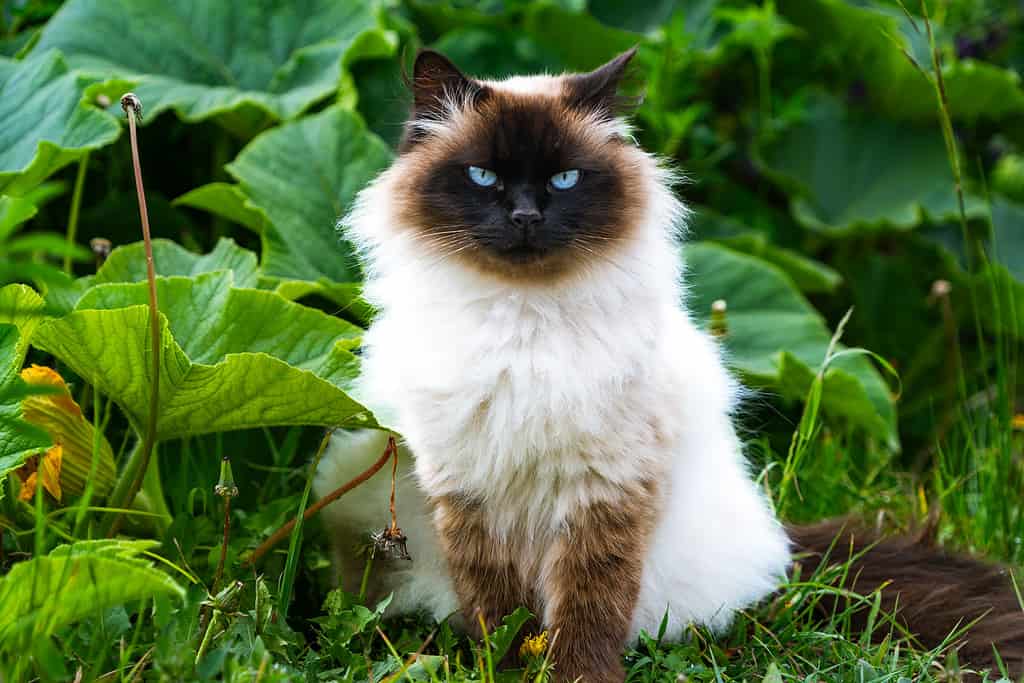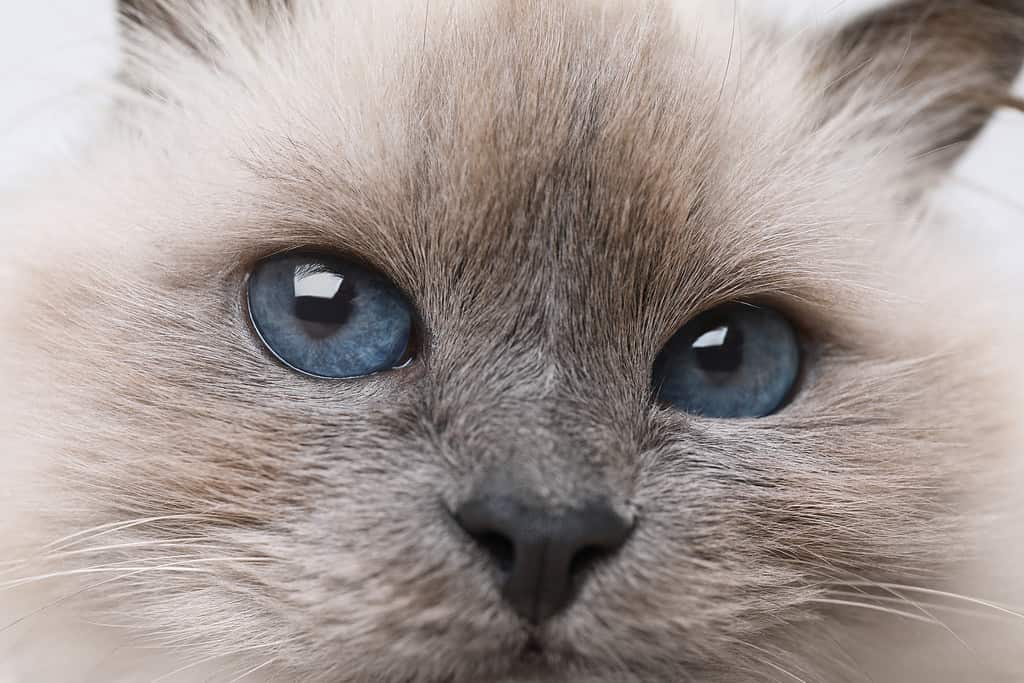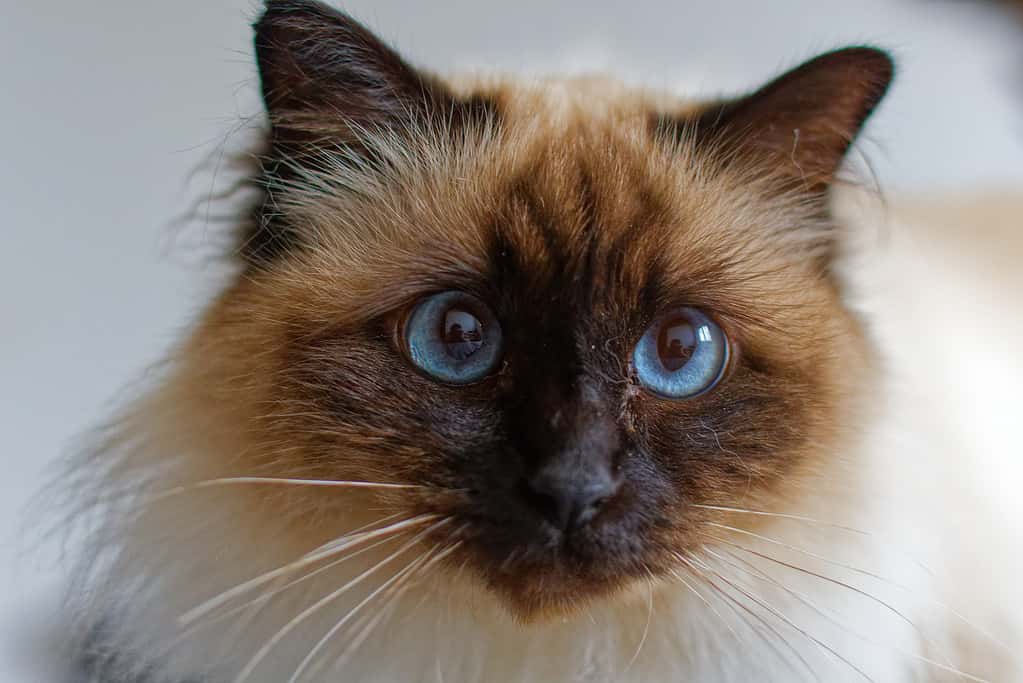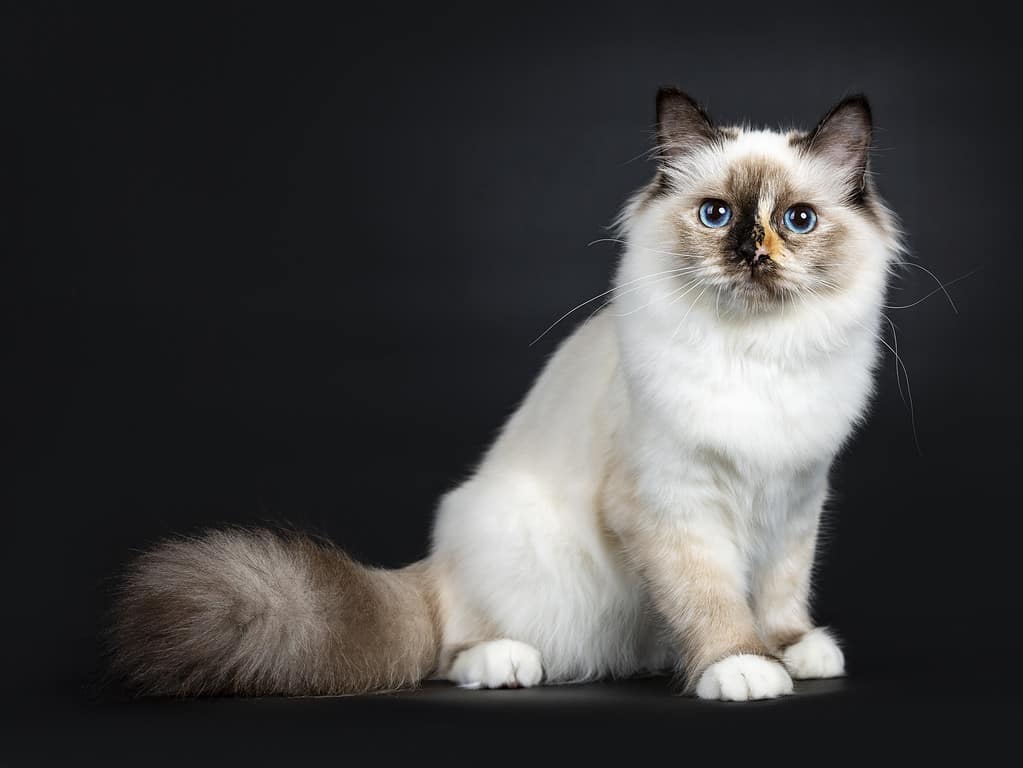Birman cats are recognizable by their stunning, pointed colors. Simply put, this means they have a pale color on their torso and a darker shade on their extremities. Heat affects their pigment. So, they are paler in the places where the cat is warmer (like on their torso).
Birman cats are also born entirely white. It takes a few days for their extremities to cool, creating their pointed coloration.
However, Birman cats may come in several point colors, including:
1. Seal Point

This coloration is the most common, and the color tends to mature faster than others.
©ecuadorplanet/iStock via Getty Images
Seal-pointed cats are probably the most common Birman cats out there. The cat’s body is white, but their ears, face, and limbs are a deep seal brown. Cats tend to darken as they age, so kittens may not have the same deep brown color as adults.
Seal-pointed cats can also have white mittens, so the very tips of their feet may not be brown.
Depending on the feline, their body may also be more cream-colored than white. Once again, adults and seniors tend to be darker than kittens.
2. Blue Point

Despite their name, these cats are more gray than blue.
©Liudmila Chernetska/iStock via Getty Images
Blue point is another traditional color. You’ll find tons of kittens with this coloration, and it’s often one of the more sought-after due to its subdued color. Despite its name, these cats are actually blue. Instead, they develop grey points as they age.
These points often only start on the tip of their nose and ease, but they will grow into larger patches as they get older. Some cats may be a darker grey, while others may be lighter in color. It depends partially on the cat’s environment, age, and genetics.
While cats will also develop grey limbs with this coloration, it tends to be less dark than other colorations.
3. Chocolate Point

As you can see, these cats are dark brown. They’re very orange around the edges in most cases.
©bru_greg/iStock via Getty Images
Chocolate point cats tend to be exceptionally brown. You may be thinking, “Wait, I thought seal point meant brown?” Yes, that is true. But chocolate-pointed cats are far more brown. The color resembles a milk chocolate bar smeared on their face – with a lot more reddish undertones.
Seal point cats tend to be more subdued.
They’re both brown, but the shades are very different. You’ll see what we mean if you look at the pictures we’ve provided of both cats.
These cats have more subdued leg coloration in most cases, especially as kittens.
4. Lilac Point

This color cat has extremely light colors. It takes a long time for this color to develop.
©Liudmila Chernetska/Shutterstock.com
Lilac pointed Birman cats are very desirable. They aren’t actually purple like their name suggests. Like many cat colorations, the name is a bit of an extravagance. Instead, they’re more of a light grey. They’re much more white than other cat colors for this reason. They don’t get as dark, even as adults.
Their body color usually remains very clear and pale. Some even have a significant pinkish tone, which also helps them remain lighter.
5. Red Point

Red Birman cats are very similar to chocolate but have a much more red undertone.
©Bigandt_Photography/iStock via Getty Images
While these cats are called red, they aren’t as red as some other breeds. Instead, they often have a small amount of orange on their nose, ears, feet, and tail. As kittens, only the tip of their nose may have color. As they get older, this does expand. However, the lighter nature of the orange makes it far less noticeable.
It is normal for red point cats to have tiny tabby markings inside their colored patterns. You may see colored stripes on their foreheads or legs, for instance. The areas free from markings may be very light or even completely white.
6. Cream Point

All Birman cat colors start white at birth. It takes several weeks for their color to develop.
©© 2017 Kryssia Campos/Moment via Getty Images
Cream cats are very similar to red ones. However, they’re much lighter. In some cases, it may be hard to notice that these cats have any color at all. Kittens are especially light and may only have a few splotches of color on their nose. This point color takes the longest to mature, so you may not notice much color when you bring your kitten home.
Cream points regularly have tabby markings, as well. The markings are often less noticeable than red, though, as they are much lighter.
7. Tortie Point

This pattern is a mix of at least two different colors.
©Nynke van Holten/iStock via Getty Images
Tortie points are pretty rare. These come in one of the first four colors we listed, but their coat includes more than one color. For instance, a cat may be lilac and chocolate. Some cats have a pretty 50/50 coloration, while others may have most of one color.
Sometimes, it’s hard to notice this coloration until the cat is older. It takes a bit for the color to mature, and it’s easy for the white to overwhelm lighter colors. Once the cat gets older, the tortie pattern should be much more apparent.
The photo featured at the top of this post is © Wirestock/iStock via Getty Images
Thank you for reading! Have some feedback for us? Contact the AZ Animals editorial team.







